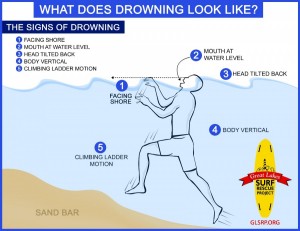Summer is just around the corner and while most people think sunshine, vacations, and picnics with the family, those of us in the aquatic education industry begin thinking about the more dangerous side of summer: the very realistic problem of drowning. Every year we hear about children drowning, typically during the summer months.
Every day, about ten people die from unintentional drowning. Of these, two are children aged 14 or younger. Drowning is the third leading cause of death from unintentional injury worldwide, accounting for 7% of all injury-related deaths according to 2004 data from the World Health Organization. In the US, drowning is the leading cause of unintentional death among children age 1-4 years old and the second leading cause of unintentional death for children under the age of 15 years old.
The Truth About Drowning
Children do not understand the dangers of water and the threat of drowning. Unfortunately, it seems that many parents also do not understand the dangers of water. Drowning is silent. It is not the dramatic, frantic event that is portrayed in movies and on television. Most people think of drowning and picture splashing, yelling, and frantic waving. However that is not the case. The swimmers around the boy in the video below were completely unaware of what was going on. Approximately one half of all drowning victims are within 25 feet of their parent or another adult.
Video of near-drowning incident
Mario Vittone is a former helicopter rescue swimmer for the US Coast Guard and is a leading expert in drowning. In an article for Slate.com, Mr. Vittone explains the signs of drowning and what actions to pay attention to when at the pool or beach.
Drowning Doesn’t Look Like Drowning
The Instinctive Drowning Response—so named by Francesco A. Pia, Ph.D., is what people do to avoid actual or perceived suffocation in the water. And it does not look like most people expect. There is very little splashing, no waving, and no yelling or calls for help of any kind. To get an idea of just how quiet and under-dramatic from the surface drowning can be, consider this: It is the second leading cause of accidental death in children ages 15 and under (just behind vehicle accidents)—of the approximately 750 children who will drown next year, about 375 of them will do so within 25 yards of a parent or other adult. In some of those drownings, the adult will actually watch the child do it, having no idea it is happening. Drowning does not look like drowning—Dr. Pia, in an article in the Coast Guards “On Scene” magazine, described the Instinctive Drowning Response like this:
 “Except in rare circumstances, drowning people are physiologically unable to call out for help. The respiratory system was designed for breathing. Speech is the secondary or overlaid function. Breathing must be fulfilled before speech occurs. Drowning people’s mouths alternately sink below and reappear above the surface of the water. The mouths of drowning people are not above the surface of the water long enough for them to exhale, inhale, and call out for help. When the drowning people’s mouths are above the surface, they exhale and inhale quickly as their mouths start to sink below the surface of the water. Drowning people cannot wave for help. Nature instinctively forces them to extend their arms laterally and press down on the water’s surface. Pressing down on the surface of the water permits drowning people to leverage their bodies so they can lift their mouths out of the water to breathe. Throughout the Instinctive Drowning Response, drowning people cannot voluntarily control their arm movements. Physiologically, drowning people who are struggling on the surface of the water cannot stop drowning and perform voluntary movements such as waving for help, moving toward a rescuer, or reaching out for a piece of rescue equipment. From beginning to end of the Instinctive Drowning Response people’s bodies remain upright in the water, with no evidence of a supporting kick. Unless rescued by a trained lifeguard, these drowning people can only struggle on the surface of the water from 20 to 60 seconds before submersion occurs.”
“Except in rare circumstances, drowning people are physiologically unable to call out for help. The respiratory system was designed for breathing. Speech is the secondary or overlaid function. Breathing must be fulfilled before speech occurs. Drowning people’s mouths alternately sink below and reappear above the surface of the water. The mouths of drowning people are not above the surface of the water long enough for them to exhale, inhale, and call out for help. When the drowning people’s mouths are above the surface, they exhale and inhale quickly as their mouths start to sink below the surface of the water. Drowning people cannot wave for help. Nature instinctively forces them to extend their arms laterally and press down on the water’s surface. Pressing down on the surface of the water permits drowning people to leverage their bodies so they can lift their mouths out of the water to breathe. Throughout the Instinctive Drowning Response, drowning people cannot voluntarily control their arm movements. Physiologically, drowning people who are struggling on the surface of the water cannot stop drowning and perform voluntary movements such as waving for help, moving toward a rescuer, or reaching out for a piece of rescue equipment. From beginning to end of the Instinctive Drowning Response people’s bodies remain upright in the water, with no evidence of a supporting kick. Unless rescued by a trained lifeguard, these drowning people can only struggle on the surface of the water from 20 to 60 seconds before submersion occurs.”
Look for these other signs of drowning when persons are in the water:
- Head low in the water, mouth at water level
- Head tilted back with mouth open
- Eyes glassy and empty, unable to focus
- Eyes closed
- Hair over forehead or eyes
- Not using legs—vertical
- Hyperventilating or gasping
- Trying to swim in a particular direction but not making headway
- Trying to roll over on the back
- Appear to be climbing an invisible ladder
This doesn’t mean that a person who is yelling for help and thrashing isn’t in real trouble—they are experiencing aquatic distress. Not always present before the Instinctive Drowning Response, aquatic distress doesn’t last long—but unlike true drowning, these victims can still assist in their own rescue. They can grab lifelines, throw rings, etc.
Sometimes the most common indication that someone is drowning is that they don’t look like they’re drowning. They may just look like they are treading water and looking up at the deck. One way to be sure, ask them, “Are you all right?” If they can answer at all—they probably are. If they return a blank stare, you may have less than 30 seconds to get to them. And parents—children playing in the water make noise.
When they get quiet, you get to them and find out why.
What factors influence drowning risk?
Lack of Swimming Ability: Many adults and children report that they can’t swim. Research has shown that participation in formal swimming lessons can reduce the risk of drowning among children aged 1 to 4 years.
Lack of Barriers: Barriers, such as pool fencing, prevent young children from gaining access to the pool area without caregivers’ awareness. A four-sided isolation fence (separating the pool area from the house and yard) reduces a child’s risk of drowning 83% compared to three-sided property-line fencing.
Lack of Close Supervision: Drowning can happen quickly and quietly anywhere there is water (such as bathtubs, swimming pools, buckets), and even in the presence of lifeguards.
Location: People of different ages drown in different locations. For example, most children ages 1-4 drown in home swimming pools. The percentage of drownings in natural water settings, including lakes, rivers and oceans, increases with age. More than half of fatal and nonfatal drownings among those 15 years and older (approximately 57%) occurred in natural water settings.
Protecting Your Family
Our goal and passion is to educate children and adults about the importance of water safety and create water-wise children. We believe that drowning can be prevented, when the proper steps are taken. Here are a few tips for parents to help ensure that your family has a safe and enjoyable time at the pool:
- Whenever infants and toddlers are in or around water, an adult should be within an arm’s length, providing “touch supervision.”
- In addition to parental supervision of young children, designate a “Water Watcher” to maintain constant watch over children in or near the water. The “Water Watcher’s” job is to watch the water at all times, without engaging in social activities, conversations, phone calls, reading, computer use, cooking, cleaning, or any other distracting activity. After fifteen minutes, a new “Water Watcher” should be designated so that supervision stays fresh. Ensure that the “Water Watcher” is a sober adult who knows CPR and has basic swimming skills.
- Do not use flotation devices as a substitute for supervision. “Water wings” or “floaties,” inflatable water rings, and other pool toys are NOT safety devices. Some flotation devices are designed to assist with building swimming skills and are designed to tilt children into a forward swimming motion. This could create risk for an unassisted young swimmer. Only US Coast Guard approved life jackets are designed and tested for safety.
- Consider using a certified lifeguard for residential gatherings that include swimming activities.
- We also offer free programs to schools, neighborhood organizations, churches, or anyone who is interested in learning more about water safety and drowning prevention.
For more information about these programs, please contact Kim by submitting a Contact Form and indicating “Water Safety Programs” as the subject. If you have any questions regarding water safety, please contact us!
While we can never guarantee that a child is “drown proof” we hope that by providing information and resources, we can help families within our community be prepared this summer.
Resources
http://www.cdc.gov/HomeandRecreationalSafety/Water-Safety/waterinjuries-factsheet.html
http://mariovittone.com/2011/07/video-of-instinctive-drowning-response/
http://www.poolsafely.gov/drowning-deaths-injuries/
